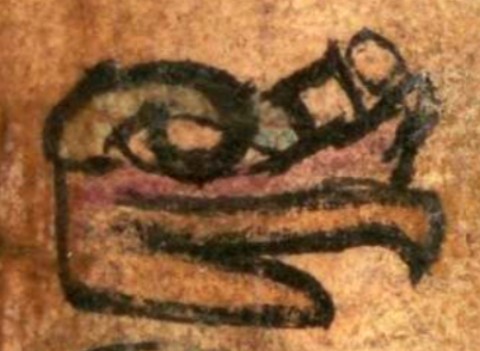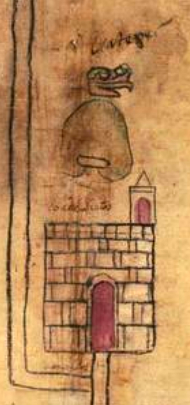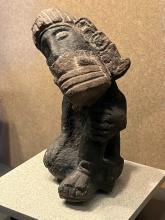Ecatl (CQ)
This element represents the deity or divine force called Ehecatl (even though the gloss starts "Eca-). It has been carved from the compound glyph for the place name, Ecatepec. The image consists of a bird-like head, shown in profile view, facing to the viewer's right. Its three-part beak has a point on the top level, a long middle section with a downward hook, and a shorter lower section. The head is painted three colors, a turquoise blue, red, and gold or yellow. It has a small white square and a small white circle on top of its beak (or what some sources describe as a duck bill, but which was apparently perceived by the Nahuas as a blowing device).
Stephanie Wood
Ecatl (air, breath) is a noun in Nahuatl that sounds much like the word for wind (ehecatl). The latter was also a proper name for the deity of the wind, Ehecatl. In turn this deity was an aspect of the creator (with Quetzalcoatl associations) and with the night. This representation of Ehecatl (which was also a name borne by some humans, given that it was a day sign in the calendar) was apparently how humans saw the deity associated with the wind. The second sun on the Aztec sun stone has a much more elaborate representation of the wind; this epoch was ruled by Quetzalcoatl. The second sun was destroyed by hurricanes and the people were turned into monkeys. For other images of Ehecatl and more information about his shape and that of Quetzalcoatl, see Mexicolore. One of the pre-Columbian statues devoted to the wind gives him a monkey's body but the same buccal mask (large point above the mouth or beak) as we see in this glyph. A type of hummingbird has the name ecahuitzilin, which shows another possible connection between the divine force associated with the wind and birds. But the ecahuitzilin seems to have coloring that is different from the visual in this glyph. Some humans had the name Ecatl or Ehecatl, which could sometimes feature this representation of the divinity or deity.
Gabrielle Vail and Christine Hernández (Re-Creating Primordial Time, 2013, ) describe Ehecatl as the wind aspect of Quetzalcoatl, and they note that Ehecatl "wears a buccal (duck) mask through which to blow wind." That the "beak" may have been perceived as a blowing device is supported by the glyph for Pitztli (below).
John Montgomery drew a group of wind glyphs (possibly mainly Mixtec), showing the variety of ways the blowing device might look. It is published in FAMSI, Inc.
Stephanie Wood
covers ruling men and women of Tecamachalco through 1593
Stephanie Wood
air, wind, aire, viento, deities, deidades, divinities, divinidades, fuerzas sagradas
Ehecatl. A seated figure with attributes of the wind divinity Ehecatl, Museo Nacional de Antropología e Historia, Salón Mexica. According to the Museo, "The headdress, the earflares and the half mask with a bird's beak express, with the slight movements of his head, the flow of the winds that preceded the arrival of the rains." Remnants of red coloring still appear on parts of the stone carving. Photograph by Stephanie Wood, 14 February 2023.

eca(tl), air, breath, https://nahuatl.wired-humanities.org/content/ecatl
eheca(tl), wind, wind deity, https://nahuatl.wired-humanities.org/content/ehecatl
Ehecatl, la divinidad o deidad del viento
Stephanie Wood
The Codex Quetzalecatzin, aka Mapa de Ecatepec-Huitziltepec, Codex Ehecatepec-Huitziltepec, or Charles Ratton Codex. Library of Congress. https://www.loc.gov/item/2017590521/
The Library of Congress, current custodian of this pictorial Mexican manuscript, hosts a digital version on line. It is not copyright protected.











